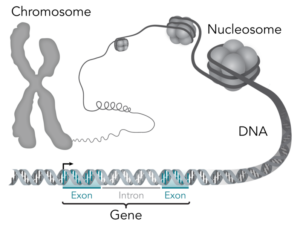Protein Synthesis
Learning Outcomes
- Discuss the potential implications of mutations at cellular, organismal, and evolutionary levels
- Summarize the processes involved in protein synthesis.
- Describe how mutations affect the process of protein synthesis and its products.
In both prokaryotes and eukaryotes, the major purpose of DNA is to provide the information needed to construct the proteins necessary for the cell can perform all of its functions. Proteins are large, complex molecules that play many critical roles in the body. They do most of the work in cells and are required for the structure, function, and regulation of the body’s tissues and organs.
Recall that proteins are made up of hundreds or thousands of smaller units called amino acids, which are attached to one another in long chains. There are 20 different types of amino acids that can be combined to make a protein. The sequence of amino acids determines each protein’s unique 3-dimensional structure and its specific function.
Table 1: Some of the functions of proteins in cells, listed in alphabetical order:
| Function |
Description |
| Antibody
|
Antibodies bind to specific foreign particles, such as viruses and bacteria, to help protect the body. |
| Enzyme
|
Enzymes carry out almost all of the thousands of chemical reactions that take place in cells. They also assist with the formation of new molecules by reading the genetic information stored in DNA. |
| Messenger
|
Messenger proteins, such as some types of hormones, transmit signals to coordinate biological processes between different cells, tissues, and organs. |
| Structural component
|
These proteins provide structure and support for cells. On a larger scale, they also allow the body to move. |
| Transport/ storage
|
These proteins bind and carry atoms and small molecules within cells and throughout the body. |
The information to make proteins is stored in an organism’s DNA. Each protein is coded for by a specific section of DNA called a gene. A gene is the section of DNA required to produce one protein. Genes are typically hundreds or thousands of base pairs in length because they code for proteins made of hundreds or thousands of amino acids.
Remember that DNA in eukaryotes is found as long linear molecules called chromosomes (Figure 1). Chromosomes are millions of base pairs in length and each contain many, many genes (Table 2). An organisms complete set of DNA (including all its genes) is referred to as its genome.
Table 2 Size and number of genes of several human chromosomes.
| Chromosome | Size (in base pairs) | # of genes |
| 1 | 248,956,422 | 2058 |
| 10 | 133,797,422 | 733 |
| 22 | 50818468 | 488 |

To summarize: many base pairs make up one gene, many genes are found on one chromosome, and many chromosomes can be found in one genome.

References
Unless otherwise noted, images on this page are licensed under CC-BY 4.0 by OpenStax.
“What are proteins and what do they do?” by U.S. National Library of Medicine is in the Public Domain

